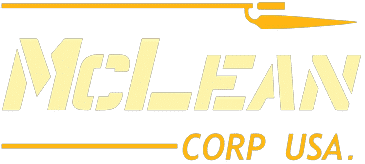The advantages of a tactical flashlight are numerous and this is why McLean Sling has partnered with Inforce. They are quick target acquisition, low-light visibility, and for distracting opponents. However, there are some nuances to consider when buying and using a pistol light or rifle light for the first time.
How can a tactical flashlight help you?
While weapon-mounted flashlights like the Inforce WML Tactical Rifle Light or the Inforce WMLx Tactical Rifle Light are excellent for fighting with shotguns and rifles, they do not always provide a perfectly round beam like one would expect with a handheld light or a pistol-mounted light.
This is because pistol-mounted lights and handhelds almost always have the head of a flashlight either clear or flush with the muzzle of the firearm. This is rarely the case with a rifle-mounted tactical flashlight. If you’ve never used one before, you should be aware of the silhouette caused by mounting a rifle light on your rifle’s Picatinny rail. Depending on the length of your barrel and where your tactical flashlight is mounted, your beam will have some kind of distortion. The more “gun” there is forward of your beam, the more shadow you will have. Knowing this, it’s best to mount your flashlight as close to the tip of your weapon as possible.
The more “gun” there is forward of your beam, the more shadow you will have.
This shadow of your barrel can be used as a reference point for your point of impact. It’s good to train on a low light range to determine where exactly that point would be. If you memorize that sweet spot, you can fire from the hip at short ranges with your light instead of a red dot, which would be especially useful since low-light fights indoors are fought at close range anyway.
It’s also great to train in the darkness since it could lead to potential setbacks or advantages unique to your own weapon light setup. For example, in my own setup, I mounted my weapon light on the right side of my rifle, illuminating the iron sights for a close-range kill. Some first-time users might realize that using a tactical flashlight as a grip might not be a good idea since they tend to heat up rather quickly.
In addition to your light, there may be other attachments on your rifle like optics, bipods, a rifle sling, canted mounts and lasers. Of these attachments, the sling might be the most problematic. Picture this: You heard something in the dark and you grab your rifle from its rack. You know that if you turn on your light prematurely, you might reveal your own position. You know the layout of your own home, so you creep out into the hallway where you heard the sound, and then you turn on your rifle and see nothing but a faint white ring where your rifle flashlight head should be.
You realize that in your haste to arm yourself and respond to a potential threat, your ar15 sling has wrapped around your flashlight. Not only are you still blind but whoever is in the room can see the ring illuminating you. The solution to this problem is simple: use the one and only Dynamic Retention Sling from McLean, it’s patented design makes it unobstructive and allows for quick transitions between your rifle and sidearm, especially valuable for competition shooters and law enforcement professionals.
Firing your weapon from behind cover with a flashlight might prove to be another challenge. A well-trained shooter will know that the less exposed you are, the less chance the enemy will have of hitting you. This is common sense. Knowing this, shooters who engage from behind cover only expose the muzzles of their rifles and not much else. When most of this training is done in the daylight, there is a tendency to forget the flashlight. If only the muzzle of a rifle is exposed from behind cover, then the flashlight’s beam is still hitting your cover and shining right back at you. This is especially problematic when taking cover behind cylindrical objects such as columns one sees in parking lots. When using a rifle-mounted light, it’s best to extend your barrel further than normal to accommodate your attachment. Also, it would be good to remember that right-mounted lights are at a disadvantage when leaning out of cover on the left, while the opposite is true for lights mounted on the left.
When using a pistol with a handheld light, like the Inforce Wild1 Tactical Pistol Light or the Inforce Wild2 Tactical Pistol Light the FBI technique is best used for shooting from behind cover. Not only does it direct threats to a point of light far away from your own body, but the light will be clear of any obstructions and shadows, giving you a clear line of sight.







